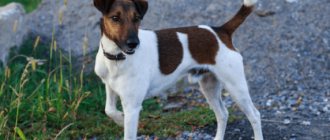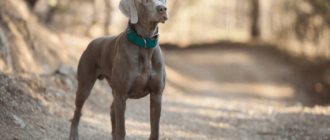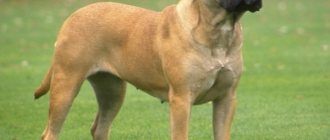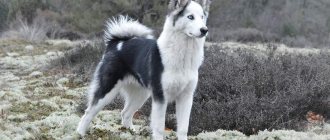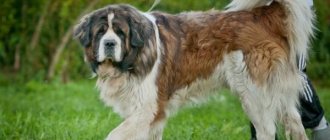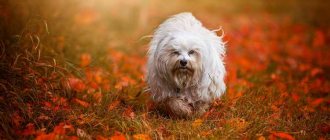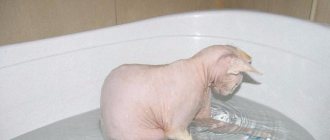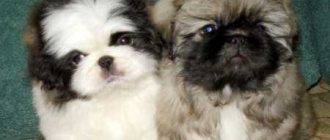Gallery of dog breeds - photo of Sluga
History of the Slugi breed
The history of the Arabian hound in Europe began at the dawn of the 19th century, when the dogs were brought by the discoverers of little-studied North Africa and Arab territories. European travelers, captivated by the opportunity to explore the previously closed Arab world and inaccessible North African lands, brought with them, along with sketches, stories about the greyhound dog Sluggi . The most detailed and accurate description of it was given by the French general Dumas in his books about the Sahara and the life and customs of the Arabs. Thus, the famous hippologist and expert on Arab culture perpetuated the memory of the servant.
The Arabian Hound's ancestors are depicted in Egyptian bas-reliefs that are over 3,000 years old. Earlier images of short-haired greyhounds with floppy ears from the heyday of Mesopotamia have also been found. Historically, a servant is a friend, a breadwinner, and, along with the Arabian horse, the most valuable thing that every Bedouin treasures. The owners valued the servants so much that the women helped the bitches feed the puppies.
In 1925, France published its own breed standard and later declared the Sluggie a French breed .
Arabian greyhounds began to be imported to Germany only in 1971. But today it is this country that has high-quality breeding material of approximately 750 individuals. In Russia, the majority of representatives of the breed are of German breeding.
Eastern greyhounds from different regions of North Africa, the Near and Middle East are sometimes almost indistinguishable from each other .
Their division into three main breeds (Saluki, Slugi (Sluggi) and Azawakh) was carried out artificially, and by Europeans. The external similarity of these animals only confirms the fact that they all belong to the same type of dog. The common ancestors of the Saluki, the Central Asian greyhound Tazy and the Kyrgyz Taigan are also known.
History of the breed
The homeland of slug is North Africa. The first mentions of frisky dogs helping Bedouins hunt date back to the 7-9 centuries BC. Mummies of Arabian greyhounds have been found in Egyptian pyramids. The first Europeans who visited African nomadic tribes in the 19th century were amazed at how the Bedouins treated the Slughi. Dogs were allowed to live in tents with the owner's family. On cold nights, the animals were covered with blankets and fed only the best meat. At the same time, strict selection was carried out in breeding the breed: only the two strongest puppies were left from the litter. If an adult dog did not show the proper working qualities, it was not allowed to be bred. The result was a dog with excellent eyesight, strong and swift, adapted to the harsh conditions of the desert.
Servants came to Europe at the end of the 19th century, first they were brought to France. During the world wars of the 20th century, the European greyhound population virtually disappeared. The breed began to be revived only in the second half of the century. Due to the ban on hunting with greyhounds in Europe and in the French colonies of Africa, the number of dogs remained critically low for a long time. Only towards the end of the 20th century did the number of slugs increase, and now the best working qualities of Arabian greyhounds are honed in competitions.
Description of the Sluga breed, characteristics
Dogs of this breed are raised by many North African tribes, they are especially valued by nomads who use sluggi as a guard and hunting dog. In Europe and America, these dogs participate in racing and are also valued as decorative family pets.
The character of the servant
Slugs are affectionate, loyal, but rather capricious , independent and proud dogs. They love comfort and cannot stand loneliness , and adapt well to the rules in the house . They become very attached to their owner and have a hard time with a change of owner, but these dogs do not like to show their affection. But they are always ready to protect the people they love.
Dogs of this breed are difficult to train , they obey only those they truly respect, and do not accept punishment. When training servants, you need to be patient; a commanding tone will not give the desired result. The early period of development is of great importance; at this time, communication between the puppy and people is extremely necessary.
Slugs are very active dogs and require serious exercise. These dogs have a strong hunting instinct (they will chase animals running away from them), so when going out for a walk, fasten the dogs on a leash and let them run in a safe place (away from highways).
Slugs are the most distrustful of strangers among greyhounds ; this quality makes them excellent watchdogs; they are very attentive to the safety of their owners. If she liked the guest, she herself will take the first step to make friends and do not like it when people force themselves on them. These greyhounds get along well with children, they are patient and forgiving, but do not like to be pulled . You should not leave a child with a dog of any breed unattended. If the slave is accustomed to the presence of other animals in the house from an early age, there should be no problems with them living together. They get along well with dogs of similar personalities, but can behave aggressively towards an unfamiliar dog on the street.
Sluggi colors
- cream or different shades of sand, often with a dark mask,
- Black and tan color with light markings is also found.
Slugi breed standard
- Standard: FCI slugs No. 188d
- Country of origin: Morocco.
- General appearance and disposition: Slugi is one of the 10 greyhounds that make up the group. Its origin comes from the East; many centuries ago this breed settled in North Africa. These days it is most common in Morocco. In general appearance, this is one of the most purebred dogs due to its gait, thin skin and developed dry muscles. Despite her nobility and pride, she is very affectionate to her master and protects him from dangers. The hunting instinct contributes to long-term performance. Nevertheless, he understands the benefits of comfortable living in an apartment.
- Height: males - 66-72 cm, ideal height 70 cm; females - 61-68 cm, ideal - 65 cm.
- Structure: in males 70 cm tall, the body length should reach 67-68 cm. In females with an ideal height of 65 cm, the body length should reach 62-63 cm.
- Type: unified, short-haired.
- Specialization: rutting hunting.
- Head: elongated in profile, elegant, graceful, but somewhat powerful. When viewed from above, it resembles an elongated triangle. Skull: Forms the widest part, tapering towards the tip of the nose. In profile, the upper part of the skull is flat and quite wide, from ear to ear 12-13 cm, in large dogs 14 cm, but this is quite rare. It is distinctly rounded at the back and symmetrically turned inward on both sides. The eye sockets protrude slightly. The bridge of the nose is barely noticeable. Distinct occipital bone.
- Muzzle: in the shape of an elongated, pointed triangle without hypertrophy, approximately the same length as the skull.
- Mouth: straight from the junction with the skull.
- Nose: the nasal planum is black, somewhat heavy. The tip of the nose is boneless and forms a very slight downward bend.
- Lips: Tender and elastic, fitting well to the lower jaw. The corner of the mouth is as invisible as possible. Normal, strong and regular jaw, similar to forceps.
- Eyes: large, dark, deep-set in the sockets, sometimes slightly covered with slightly slanted eyelids. The look is soft, a little sad, full of nostalgia. With a light color, the eyes are usually amber in color.
- Ears: Set high, drooping, fitting well to the head. Not too big, at the end in the shape of a slightly rounded triangle.
- Neck: long, very slender. In profile, the upper part is slightly curved.
- Body: back short, almost horizontal. Gachas are short, dry, wide and slightly convex. Large-bodied and slanted. The chest is not too wide, barely reaching the elbow. Well developed in depth. The ribs are flat, attached to a long and tucked sternum. The belly and sides are lean.
- Tail: thin, base at the extension of the croup, located below the line of the back. Should reach at least to the hock joint.
- Forelegs: Shoulders elongated and sloping. Strong legs. The forearm is bony and muscular. The wrist and metacarpus are elastic and strong.
- Paw: thin, elongated oval. Many lighter-type slugs develop almost a hare's foot. Claw black or colored.
- Hindquarters: Gachas are flat and muscular. The legs are long and very muscular. The hock joint is strong and well arched. The ankle is strong, without a false claw.
- Jog: walk, trot, gallop.
- Skin: very thin, tight-fitting, without folds or sags.
- Dog's body: very short, smooth-fitting and thin.
- Color: sand, light sand, red sand, gray sand, with tan marks, with or without a black “mask”, with or without a black “collar”.
- Defects:
- Light eyes.
- The bridge of the nose is too prominent.
- Bad proportions.
- Bad back line.
- Round ribs. The croup is too sloping, too narrow or small.
- The tail is too thick.
- The abdomen is weakly tucked.
- A rough or tough dog.
- Small white spot on chest.
The head and structure are somewhat awkward.
- leprosy;
Breed
Arabian greyhounds, like other representatives of the breed line, are distinguished by their refined and gentle exterior. However, unlike the affectionate sissies of whippets or galgos, slugs have a rather tough temperament, which not everyone, even an experienced dog breeder, can cope with.
Important! Life in the harsh conditions of the Arabian desert made greyhounds very hardy, unpretentious and strong. They have a very stable psyche and complex character, tempered under the desert sun.
Despite all their independence and self-confidence towards their owner, servants experience truly strong and real feelings of love and devotion. If a dog has to deal with a change of owner, it experiences extreme stress, which can leave an indelible imprint on the rest of its life. But even with such selfless and strong love for the owner, the servant will never beg for affection and lie at his feet. These greyhounds believe that wagging their tail at the sight of their owner is enough to show feelings. You shouldn't expect slobbery kisses and jumping on arms from a servant.
Important! Servants are terrible perfectionists who quickly get used to a certain routine and react poorly to any innovations. Stress in a dog can be caused by moving, renovation, or a change in daily routine. Disruption of the microclimate in the family can also have a negative impact on the condition and behavior of the dog. If there are frequent quarrels, scandals and screams where the greyhound lives, the dog will become nervous and unbalanced.
The Arabian greyhound is wary of strangers, which makes it a good guard and watchman. Also, do not forget that the slave is primarily a hunter and a pretty good one, so even cats and dogs living with her under the same roof can sometimes become objects for practicing skills and abilities.
Important! In the process of training an Arabian greyhound, owners often encounter the intransigence and willfulness of their pets. If you make concessions to the dog, the training may completely come to naught. To prevent this from happening, you need to be patient and persistent, not allowing yourself to be cruel.
Servant food
The Arabian Greyhound is famous for its pickiness in matters of food and maintenance. In order for slugs to be healthy, they must be fed properly. Small puppies love dairy products, but are not averse to eating meat. As the dog grows up, the diet should be varied so that there is enough energy for training and walks. It is better to feed her at the same time. She quickly gets used to the feeding place and never throws food around.
What to feed Slug puppies if you have just brought small pets to their new home?
At the very beginning, it is necessary to provide the same diet that the breeder had. For complete information, ask how the breeder prefers to feed older individuals.
Be sure to remember that you need to feed the younger generation several times a day, unlike older dogs. Slugi dogs are unpretentious in food, they love raw meat, but feeding it only will not improve your pet’s health.
The following products should be gradually introduced into the puppy’s diet, starting from the age of two months:
- milk;
- raw or boiled egg;
- Porridge, preferably with meat broth; grated vegetables; meat, cut into small pieces.
If we talk about what to feed Slugi at a more mature age, then you can adhere to a similar diet, but it would be better to replace milk with cottage cheese or kefir. In general, Slugi puppies should be accustomed to fermented milk products from an early age. Because by the age of one, dogs have already developed their own eating habits, so they can simply ignore sour dairy products.
The following types of foods should be completely excluded from the diet of both young and adult dogs:
- Fried or smoked foods. They can cause basic digestive problems, subsequently gastritis or basic allergies.
- Sweets. It's not just chocolate and candy. These include cakes, gingerbread cookies and sweet biscuits.
- Fatty foods.
It goes without saying that the health of any dog is based primarily on what it eats. An animal that is fed incorrectly and lacks mobility becomes overweight, begins to suffer from apathy, and exhibits lethargy in behavior. The dog gradually loses interest in everything; needless to say, the life expectancy of such a pet is sharply reduced.
Health
Representatives of this type of individuals are not distinguished by particularly good health and resistance to the environment. Even though the skin is thin and the hair is short, it can be blown away by a draft or strong wind during a walk. She should also ensure that her eyes are checked regularly.
The fact is that the Arabian Greyhound tracks prey first with its eyes, then its sense of smell comes into play. But genetically, the retina often fails them and begins to deteriorate, causing decreased vision, and then blindness may occur. It is important to have your eyeballs examined regularly by a veterinarian to be aware of the stage of the disease or health.
The teeth of this breed are prone to the appearance of tartar, so you need to brush them regularly and give your pet special treats to chew. They are made in such a way that they remove minor plaque and prevent new ones.
Dog care and maintenance
This dog sheds moderately . Periodically, the slugs should be cleaned with a hard-bristled brush.
You should only bathe your dog if absolutely necessary, and it is better to remove dirt from the coat with dry shampoo. The fact is that slugs have very dry skin , which can become even drier from frequent bathing.
Features of caring for servants
If you don’t have time for daily multi-hour walks, then slugs are definitely not suitable for you. These greyhounds are nimble and need to spend at least 3 hours a day outdoors. Moreover, each walk should be accompanied by fast runs over long distances.
Another feature of caring for dogs of this breed is that the owner must ensure that their pet does not freeze. Slugs tolerate heat well, but frost and drafts can undermine their health. With the onset of cold weather, it is necessary to dress the dogs in dog clothes and not allow them to become hypothermic.
The dog sheds rarely and sheds a small amount of hair. Daily brushing is not required; it is enough to brush the dog’s body once a week with a hard-bristled brush. You should bathe your pet only when it is heavily soiled, as frequent water procedures cause the dog’s thin skin to become too dry and dandruff appears.
When selecting food, preference should be given to series for dogs with increased activity. Such food is high in calories and provides the animal with the necessary energy for playing and running. For example, Hill's Science Plan Advanced Fitness, Chicopee Pro Nature Line Active, and Belcando Adult Active are suitable for adults.
Due to the fact that slugs do not tolerate frost, dampness and drafts well, in the off-season and in winter they can become hypothermic and catch a cold.
Raising and training servants
Slugi is very smart, and therefore stubborn and willful. Their character does not allow them to be easily trained - servants reject any attempts to change their personality. Rigid teaching methods are not suitable here.
This breed requires respectful treatment; a strict but fair coach.
Lessons should be repeated often, and the dog should be rewarded with something tasty for success in training. It is difficult to train a slug to go to the toilet on the street, however, when teaching this skill, you should not abuse the special cage, since this breed suffers from a mild degree of claustrophobia.
Slough training should first of all be aimed at teaching the dog the most basic commands: “Stand.” "To me". “You can’t” and others. During their training, punishment should not be used; on the contrary, the pet should be encouraged and encouraged, and an additional incentive should be created so that the dog is interested in the exercises. Considering that all dogs are completely different in character, only the immediate owner will be able to find the proper approach to their pet, based on complete understanding and mutual trust.
Education and training
Slugs are not dogs that can be trained. One cannot expect from them a high level of obedience and fulfillment of circus commands on demand, only response to requests in everyday life. The main task of the owner is to raise the dog from puppyhood and socialize it well. Gentle and fair teaching methods are appropriate. They are very sensitive and do not respond well to raised voices and physical punishment. It is also important that the dog sees its owner as a leader and mentor.
Vaccinations for Arabian Greyhounds
Vaccination is carried out against the following diseases:
- canine distemper or distemper;
- parvovirus enteritis - the causative agent is parvovirus;
- infectious hepatitis - causative agent hepadnavirus;
- parainfluenza;
- rabies;
- leptospirosis;
- coronavirus;
- trichophytosis.
When should a puppy have his first vaccination?
- At 2 months the first vaccination is carried out. After the injection, the puppy should not be washed, overfed or taken outside. Immunity after the first vaccine is developed within 12 days; this period becomes the most dangerous for the baby. A person needs to make a lot of effort to alleviate the puppy’s condition. After the first vaccination, puppies experience increased body temperature, general weakness and diarrhea.
- After 3 weeks, the puppy is given a second vaccination, but with the same vaccine. As a rule, after the second vaccination the dog feels much better, but for 12 days it must be protected from other animals, from drafts and not taken out for walks. After this time, walks are allowed.
- At 6 months of age, the puppy is vaccinated against rabies and a complex vaccine against several diseases. It is forbidden to vaccinate if the dog's teeth are changing. You need to wait until all the teeth are replaced, and then vaccinate the baby.
- At one year of age, the dog is given a comprehensive vaccine.
- Further, once a year the dog should be vaccinated with the same complex vaccine.
How to vaccinate a puppy?
Only a qualified specialist should vaccinate a puppy .
Before vaccination, he must examine the dog, measure its body temperature, and only if everything is normal, give the injection. The vaccine is placed either in the scruff of the neck or in the hip of the dog. The entire list of vaccinations administered by the veterinarian must be recorded in the dog’s passport. It also indicates the date of vaccination; subsequently, the owner himself will know the expected date of the next vaccination.
Sluggi diseases, symptoms and treatment
Slugs are very hardy and fairly healthy dogs. Among dogs of this breed, the following diseases may occur:
- progressive retinal atrophy (people breeding this breed do everything to exclude this disease at the genetic level),
- isolated cases of problems with the immune system and balance,
- hemophilia (a disease that reduces the body's ability to control bleeding) in inbred lines.
- Slugi, like many other greyhounds, are sensitive to anesthesia. Their average lifespan is 10-15 years.
Health and life expectancy
Slugs have remained virtually unchanged since ancient times and have retained strong genetic health. Life expectancy is 10-15 years. Progressive retinal atrophy is relatively rare in the breed and isolated cases of autoimmune diseases are recorded (usually in inbred lines):
- Addison's disease;
- Atrophy of the large intestine.
Many slugs note increased sensitivity to anesthesia, vaccines, antiparasitic and some other drugs.
Estrus
What should a bitch owner know?
- age of onset of the first estrus in a female is 6-12-14 months;
- duration of estrus is 20-22 days, sometimes up to a month;
- frequency of estrus – 1-2 times a year with an interval of 6-9 months;
- signs of estrus – swelling of the dog’s external genitalia, spotting;
- frequent urination - having to walk more often than usual;
- psychological signs - a change in the dog’s behavior - from aggressive to lethargic;
- perhaps there is a change in appetite and the dog drinks more water;
- often bitches begin to shed before going into heat;
- lick the loop intensively.
How to notice the onset of heat?
You can notice the approach of estrus while walking your dog. Behavior can change, often the dog becomes active, playful and disobedient, or, on the contrary, looks unhappy and lethargic. The bitch makes frequent marks - scent “lures” for male dogs, and urination occurs more frequently. The loop becomes more and more swollen; when pressed, you can see a discharge of light pink or dull pink color. If you notice changes in the dog's behavior, do not be lazy and check the dog every day for the onset of heat by dabbing the bitch's loop with a napkin or toilet paper. Pinkish discharge will be the beginning of estrus - mark this day in your dog’s notebook.
The course of the dog's first heat.
- The first heat in dogs is not the same as the next one.
- It may be shorter or longer than the usual estrus period.
- The bitch has either only weak manifestations of estrus, or, conversely, very heavy discharge.
- The first heat may suddenly stop, and then after some time begin again.
- There may be mucous discharge from the loop, a smell that attracts males, and the estrus itself will begin after some time.
- Try not to miss the start time of the first, and subsequently the second estrus, in order to correctly determine the intervals between estrus and know their timing and duration.
Precautions during estrus.
If you are not interested in getting puppies from a dog, you need to take precautions during heat:
- walk your dog ONLY on a leash: even the most obedient dog these days can simply run away, not paying attention to commands;
- do not allow male dogs to mount the dog: if sexual intercourse begins, it is almost impossible to separate them;
- during a walk, literally DO NOT take your eyes off the dog, even when buying bread in a tent, eliminate or minimize contact with male dogs;
- there is a danger of the dog catching a cold in the cold season, the best way to protect yourself is not to walk for a very long time in cold weather and use dog clothes;
- If your dog lives freely on your territory, then from the moment the estrus begins, lock the dog in an enclosure.
History of the origin of the breed
North Africa is considered the homeland of the Arabian hound Slugi, and the first mention of them appears in the 7-9 centuries BC. The Bedouins hunted with such dogs, and in the pyramids of Egypt, together with the pharaohs, they found the mummy of a servant. Europeans visited African nomads in the 19th century and were amazed that dogs were a privileged class. She lived in a tent with her owner's family and ate meat from his table. In cold weather, the animal was covered with a warm blanket so that it would not freeze and lose its working qualities.
In ancient times, only a couple of the strongest babies could be left from the litter. If an adult animal did not show working qualities, then it was not allowed to mate. Thanks to such difficulties, they obtained an animal with one hundred percent vision; it was distinguished by its strength, swiftness, and adaptability to harsh desert conditions.
Photo from Wikipedia website
Slugs came to Europe in the 19th century, first coming to France, but almost completely disappearing during the two world wars. The revival of the breed began in the 2nd half of the 19th century, since hunting with greyhounds on European territory was prohibited until that time. Within a century, the number of purebred dogs began to grow. Nowadays, the working qualities of the slave are honed at dog shows and competitions.
In Europe, the first dogs appeared after the end of the war in Algeria - they came to France along with the soldiers. Three decades later, greyhounds became very popular when they appeared in a painting by the great Dutch artist Legrass. He depicted animals in his famous paintings and they attracted the attention of many people. During the occupation of France and several rabies epidemics, the number of slug individuals decreased significantly. In 1935, the breed was officially recognized by the international canine association FCI, but standards were developed much later.
Mating
In principle, the female is ready to meet a male and for her first heat, but you can’t breed so early!
The ideal days for mating are considered to be from 11 to 15 from the start of estrus. It is best to breed a female by the age of 2, just like males. Under no circumstances should males be bred before two years of age. Early sexual activity will not improve the health of either the dog or the offspring.
- Before mating, animals need to be given a good walk, but should not be fed. It is better to introduce dogs on neutral territory so that they can get to know each other and run around, and then lead them to the male dog’s territory.
- Matings should always be carried out only in the territory of the dog. Actually, an act of love can also happen during dating, so don’t interfere with the process.
So, you're in male territory. Most likely, no intervention will be required, and the bitch, having played enough with the male, will allow a persistent suitor to mount.
If one of the partners for mating is small in relation to the other, then you can place a pillow under the hind legs or, if the bitch is shorter, place her belly on a bent knee. This advice is more relevant for small breeds. Just don’t try to bend the bitch’s paws so that the dog can reach her.
After ejaculation, mating occurs. The male can be on the bitch or stand with his back to her. The animals will figure it out on their own. However, if the lady tries to break free or lie down, do not allow her, hold her back a little. Also try not to scare the dogs.
It happens that after mating, mating does not occur and the male immediately loses interest in the female.
Be sure to carry out a control mating after 24-48 hours.
Slugi (Arabian greyhound)
Origin
The Slughi (Arabian hound) is revered by the Bedouin tribes, who decorate it with talismans and amulets. When Bedouins visit each other, servants are treated with the same respect as any honored guest. The tribes will be happy to give the servants their own blanket so that the dog does not freeze. When a servant dies, it is a great grief for the Bedouins. There is evidence that slugi was found in ancient Egypt. The mummified body of the servant was discovered in the tomb.
Character
Slugs are independent dogs with an innate desire to hunt. They are very hardy and can walk great distances. If a dog has not been socialized from an early age, it will consider cats and other small animals to be prey. This breed is not suitable for a person who has little free time. In the right hands, a dog becomes a devoted, faithful family friend. This is not a noisy hound.
Behavior
When hunting, these dogs rely on sight rather than scent. They love to run and can sprint at incredible speeds, leaving their owners far behind! Indoors, they often behave like relaxed homebodies. However, in the open air they are constantly looking for objects to pursue. Often dogs seem deaf to their owner's commands if the chase has already begun. They enjoy walks on a leash. They are happy to be outdoors, although they can be aggressive towards unfamiliar cats and other small furry creatures. They are calm, although they rarely openly show their love for people. They usually get along well with other dogs.
Health
The Slugi (Arabian hound) is generally a healthy and robust breed. As with many breeds, hereditary eye conditions can occur and it is recommended to have your dog's eyes checked.
Physical exercise
These dogs need a lot of physical activity - at least two hours daily for an adult dog. Carried away by the game, they will run without stopping. Therefore, let your dog off-leash in safe areas and train him to consistently respond to his name.
Nutrition
Your dog's diet should provide an optimal balance of all major groups of nutrients, and do not forget that the dog should always have access to fresh and clean water. It is important to regularly evaluate body condition to keep your dog in tip-top shape. Also, be sure to feed your pet at least twice a day according to the nutritional guidelines included with certain foods.
Grooming
Slugi is a clean, easy-to-maintain dog that does not like to be dirty. She washes herself like a cat if her fur gets dirty. The short hair of such a dog should be treated with a rubber grooming glove.
The best breeds for children
Dogs are generally considered to be good with children. However, dogs and children must learn to get along with each other, respect each other and feel safe being together. In any case, small children should not be left alone with a dog; adults must supervise all interactions between them.
Pregnancy and childbirth
From the day of the first mating to the birth itself, 56 to 72 days . It is advisable to note the day of mating in order to know how long the dogs are pregnant. Too early and too late births most often lead to the death of the litter, so in both of the above cases it is necessary to seek help from a qualified veterinarian. The gestation period in dogs may be shortened due to the small number of offspring.
Typically, young females produce fewer puppies.
The litter size increases when the dog reaches 3-4 years of age, then decreases again. The duration of pregnancy in dogs is not very long; it is not so easy to determine that a dog is pregnant.
Obvious signs of pregnancy in dogs appear at quite late stages. Neither palpation nor the appearance of the pet at an early stage of pregnancy will tell the owner whether the mated bitch is expecting offspring or not. The first signs concern not so much the external appearance as the mental state, and therefore the behavior of the pregnant bitch. The dog, as a rule, becomes calmer, shows affection more often and demands affection from others. Sometimes the animal may not even seem completely healthy.
If the pregnancy is progressing normally, the specialist can establish pregnancy by palpation in the third week. After a month, the dog’s belly noticeably enlarges, and in the fifth week the mammary glands swell and lighten. Shortly before giving birth, the bitch's belly drops. A characteristic sign of approaching labor is abundant discharge from the loop, yellowish or greenish in color.
Also prepare a “maternity kit” so that everything you need is at hand, it should include:
- old duvet covers or large disposable diapers (60*90), on which the bitch will whelp (disposable diapers are preferable - less washing and more cleanliness);
- a lot of small soft rags ironed with a hot iron from old bedding (to dry puppies);
- sterile gauze wipes (usually unnecessary, the puppy’s mouth is dried with a piece of cloth, into which, in fact, the puppy is received);
- a pen, a notebook, scales and thick woolen threads or ribbons (it is better to use floss, because the bitch simply licks and removes woolen threads);
- afterbirth bowl;
- a box or basin for puppies with a heating pad (wrapped in a diaper) - this is in case the bitch behaves restlessly during childbirth and there is a risk of losing puppies... the best option is a bitch giving birth with puppies at the nipples;
- sterile scissors and a medical clamp (it is not necessary to boil; at the onset of labor, place in a jar with any alcohol);
- milk chocolate bar;
- an antiseptic, preferably a spray (Aluminium, Xidicol, Septonex) for treating the umbilical cord.
And also a puppy resuscitation kit:
- cordiamine to stimulate cardiac activity (a drop on the tongue of a newborn);
- an oxygen canister (to give a weak puppy a chance to breathe), costs about 400 rubles in pharmacies;
- small rubber heating pad;
- a small enema for suctioning mucus from the mouth of a very weak puppy.
As for medications, during a normal birth they will not be needed, and if you had to resort to the help of a veterinarian, then he will have the necessary kit. Just in case, you can keep in stock No-shpu in ampoules, glucose 5% solution for infusion; calcium gluconate (a box, may be useful after childbirth).
You will also need a watch to mark the time of birth of the puppies and a notepad to record the details of the whelping (they will come in handy in the future), with your veterinarian's phone number displayed in a visible place. It's also great to have a scale for weighing newborn puppies. The puppy's birth weight, among other whelping details, should also be recorded in a notebook.
Bitches usually whelp between 58 and 63 days. Large litters are born earlier, and small ones a little later.
In the last days before whelping, you need to monitor the bitch’s body temperature. The normal temperature measured in the anus is about 38.5°C. Two days before giving birth, the bitch's temperature usually drops to 37°C or even lower. But since this does not always happen, you need to be attentive to all other signs of impending whelping. And yet, more often than not, if the temperature remains normal, then the bitch is unlikely to whelp in the next 24 hours.
Before whelping, it is good to give the bitch a mild laxative to help her cleanse her intestines.
It is better if, 2-3 days before the expected birth, you call a veterinarian or clinic, warning in advance about a possible call; in any case, the necessary phone numbers should be in a visible place.
Various questions about the Sluga breed
How do servants treat adults, children and other pets?
Servants are wary of people they don’t know. It takes time for them to become accepting of strangers who come to your home. It is better to allow the servant to approach a stranger after he has observed this person for a while than to force the dog to introduce him to him. The Bedouins value this relationship very much, and have bred the breed in accordance with it. Slough mothers are very jealous of their offspring, so it is better to show puppies to a potential owner in the absence of their mother.
Slugs kept as barn dogs are usually poorly socialized, shy, nervous when faced with an unfamiliar situation, and may bite people out of fear. However, with patience, their behavior can be corrected.
Slugs are very kind, loving, intelligent and very loyal dogs towards their owner. Some servants have a hard time if they have to change owners, having linked their lives once and for all with a certain person. The same relationships exist between dogs of this breed. Slugs are good with children who know how to behave with dogs, and with other pets (dogs, cats, parrots, etc.).
Main diseases and problems
Most of the problems appear due to the wrong approach to taking care of psychological and physical health. The most common sore is related to the retina of the eye, which can quickly lose its functions and disconnect the dog from the screen of life. It is necessary to provide your pet with proper nutrition and show it to the doctor more often.
Also a problem is the presence of parasites that can take away useful substances; they cease to enter the body. This causes a number of other ailments, but you just need to carry out regular prevention of parasites with the help of tablets. The dog himself needs this, because herding the hind dogs, due to vitamin deficiency, is too easy, you need to eliminate all the problems and learn to regularly protect your personal space from the penetration of strangers.
There are rich people among dogs
Many owners love their pets very much, care for them and cherish them, and even include them in their will as heirs, even if there are human heirs. In the United States alone, the number of dogs that are primary heirs is estimated at more than a million.
Dogs can recognize human emotions
Dogs are the only animal species, other than humans themselves, that can recognize our emotions. A quick glance is enough for them to understand whether you are happy, embarrassed, angry or sad. They are even able to empathize with people, feeling the same emotions as their person.
Dogs can memorize hundreds of words
The average dog is as trainable as a human child and can learn between 200 and 500 words. Moreover, the dog can learn the basics of mathematics, such as learning to count and order numbers in ascending order.
Related breeds
Saluki
The Saluki is called the gazelle dog, and it is rightfully considered one of the first breeds bred by man. This animal is graceful, beautiful and has a complex character. Not every person can get along with her, but if you raise her correctly, the Persian Greyhound will become the best friend for the whole family.
Saluki is not the easiest breed to keep . These dogs are willful, intelligent and love to have their own way . But it is also a beautiful, loyal and energetic pet, for which the owner is the most precious creature in the world. And every Persian greyhound owner will confirm this. That is why these dogs are valued not only in the Middle East, but throughout the world.
Description of the breed
The Afghan Hound is a bright representative of the hunting breed
It is important for a pet to drive and catch game. She learns service commands poorly and cannot cope with the breed for a beginner.
The dog is suitable as a guard, as it barks and is aggressive towards strangers. If necessary, he will protect the owner and guard his property. In England, Afghan hounds were often used as bodyguards for the aristocracy.
Despite the disadvantages, the Afghan Hound has many advantages. The dog is attached to its owner and loves to play active games. The breed is one of the hardiest and fastest. Afghans can reach speeds of up to 50 km/h while running.
The pet is suitable for keeping in an enclosure. When living in an apartment, you should prepare for long hair on carpets and furniture.
Nicknames for dogs: names for servants
Most people prefer to choose a short, sonorous name for their dog.
You will have to say your dog's name many times a day, and if it is too long, it will be tiring.
When choosing what to call slugs, you can be guided by two methods.
- The first and easiest: open the list of the most suitable names for this breed and choose the one that you like best .
- Second: choose an unusual name from other sources, for example, from mythology or literature, name the dog after your favorite celebrity , or come up with your own exclusive name .
There are many suitable names for servant girls:
- Addie,
- Nessie,
- Alma,
- Anda,
- Becky,
- Wendy,
- Gamma,
- Gina,
- Dina,
- Isis,
- Lada,
- Lorna
The following names are good for a boy's servant:
- Argon,
- Brandon,
- Kadel,
- Quint,
- Titus,
- Flor
Irish Wolfhound
The Irish Wolfhound is considered one of the largest hunting dogs in the world and originated in Ireland. Used for hunting and protection, works well in open areas and forests, hunting hare, wolf, foxes and wild boars. Advantages – overcomes long distances, uses scent and instinct. By temperament, the wolfhound is patient, kind, loyal and well-mannered, and adores his family.

